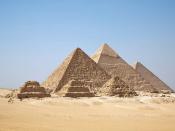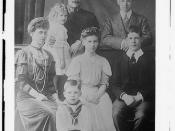The King of the New Kingdom filled a position of much importance in Ancient Egypt, both culturally and politically. It was his (infrequently her) role to be not only seen as a leader, hunter, warrior, builder, administrator and ruler of an empire, but also as a central figure in religion and religious practices.
In order to maintain his position of authority and leader status, the King was prominent in Egyptian artwork and was often depicted in reliefs and royal statues. He would be shown wearing symbols of power, such as the Red Crown of Lower Egypt, White Crown of Upper Egypt, the Blue Crown of war (even if the kind did not take part in military campaigns), the Atef Crown and various headdresses. The King would also be shown with a uraeus beard and a kilt with bull's tails and carrying a crook, flail and mace, all symbolic of his leadership.
As Egypt was known for its military prowess, it was important for the King to be seen as a hunter who used the same skills as warriors in battle. These were seen as strength, endurance, skill and courage. Depiction in commemorative scarabs of the King as hunting wild animals was representative of a conquest over chaos, which in itself was key to the maintenance of ma'at (order of the universe), another role of the King.
As one of the main roles of the King was to be the protector of Egypt, it was necessary for them to depict themselves as warriors, maintaining armies and forts, even if they themselves relied on diplomacy. The King would display all the skills of a warrior, such as archery, managing horses and charioteering, and the Sphinx was his symbol, depicted trampling the traditional enemies of Egypt. Tutankhamen's tomb held chariots and weapons, and...


![King [Haakon] and Queen [Maud] of Norway and [Crown] Prince Olaf (LOC)](https://s.writework.com/uploads/11/119823/king-haakon-and-queen-maud-norway-and-crown-prince-olaf-loc-thumb.jpg)
Pharaoh
You've written a good essay on the importance of the Pharaoh in New Kingdom Egyptian society. You have illustrated well how the Kings of New Kingdom Egypt were able to maintain their dominant position in society by using propaganda to depict themselves as vital in many areas of Egyptian life, including the practice of religion. Your report was insightful and knowledgeable. Quality work! .
8 out of 8 people found this comment useful.